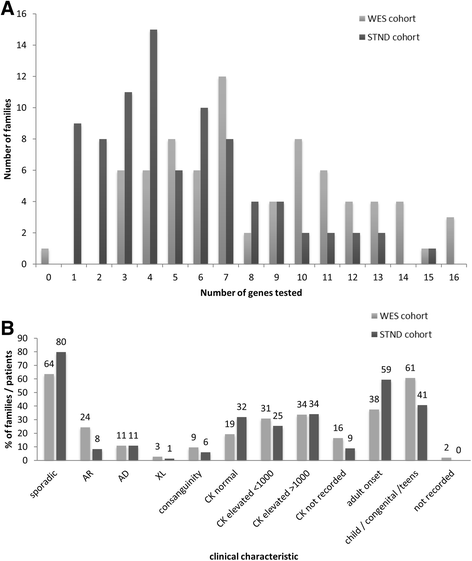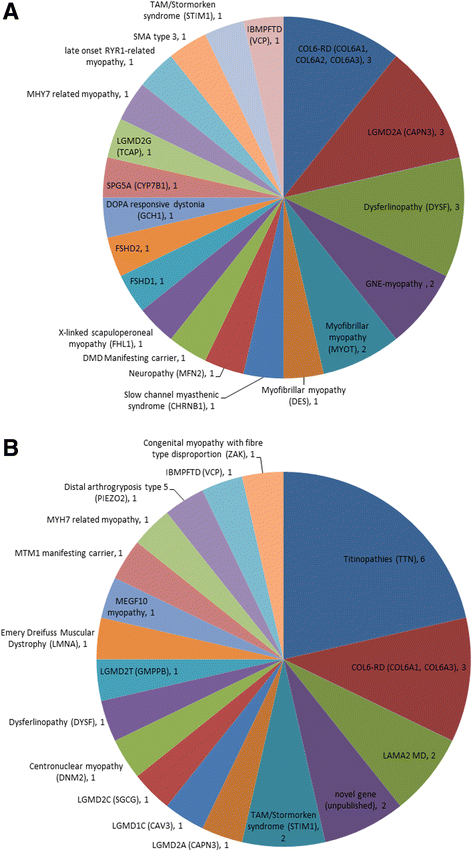Exome sequences versus sequential gene testing in the UK highly specialised Service for Limb Girdle Muscular Dystrophy
- PMID: 28877744
- PMCID: PMC5588739
- DOI: 10.1186/s13023-017-0699-9
Exome sequences versus sequential gene testing in the UK highly specialised Service for Limb Girdle Muscular Dystrophy
Abstract
Background: Limb girdle muscular dystrophies are a group of rare and genetically heterogeneous diseases that share proximal weakness as a common feature; however they are often lacking very specific phenotypic features to allow an accurate differential diagnosis based on the clinical signs only, limiting the diagnostic rate using phenotype driven genetic testing. Next generation sequencing provides an opportunity to obtain molecular diagnoses for undiagnosed patients, as well as identifying novel genetic causes of muscle diseases. We performed whole exome sequencing (WES) on 104 affected individuals from 75 families in who standard gene by gene testing had not yielded a diagnosis. For comparison we also evaluated the diagnostic rate using sequential gene by gene testing for 91 affected individuals from 84 families over a 2 year period.
Results: Patients selected for WES had undergone more extensive prior testing than those undergoing standard genetic testing and on average had had 8 genes screened already. In this extensively investigated cohort WES identified the genetic diagnosis in 28 families (28/75, 37%), including the identification of the novel gene ZAK and two unpublished genes. WES of a single affected individual with sporadic disease yielded a diagnosis in 13/38 (34%) of cases. In comparison, conventional gene by gene testing provided a genetic diagnosis in 28/84 (33%) families. Titinopathies and collagen VI related dystrophy were the most frequent diagnoses made by WES. Reasons why mutations in known genes were not identified previously included atypical phenotypes, reassignment of pathogenicity of variants, and in one individual mosaicism for a COL6A1 mutation which was undetected by prior direct sequencing.
Conclusion: WES was able to overcome many limitations of standard testing and achieved a higher rate of diagnosis than standard testing even in this cohort of extensively investigated patients. Earlier application of WES is therefore likely to yield an even higher diagnostic rate. We obtained a high diagnosis rate in simplex cases and therefore such individuals should be included in exome or genome sequencing projects. Disease due to somatic mosaicism may be increasingly recognised due to the increased sensitivity of next generation sequencing techniques to detect low level mosaicism.
Keywords: Collagen VI related dystrophy; Exome; Limb girdle muscular dystrophy; Mosaicism; Myopathy; Titinopathy.
Conflict of interest statement
Ethics approval and consent to participate
Informed consent for research was obtained from all patients undergoing WES under the protocol for Newcastle MRC Centre Biobank for Neuromuscular Diseases (REC reference: 08/H0906/28 + 5). Incidental findings [48] were not sought or reported to patients as per the agreed consent for this study. Patients attending the UK LGMD centre did so as part of their standard care.
Consent for publication
The individual identified as patient WES9 featured in Fig. 3 has provided informed consent for publication of their details and images.
Competing interests
The authors declare that they have no competing interests.
Publisher’s Note
Springer Nature remains neutral with regard to jurisdictional claims in published maps and institutional affiliations.
Figures



References
-
- Narayanaswami P, Weiss M, Selcen D, David W, Raynor E, Carter G, Wicklund M, Barohn RJ, Ensrud E, Griggs RC. Evidence-based guideline summary: diagnosis and treatment of limb-girdle and distal dystrophies: report of the guideline development subcommittee of the American Academy of Neurology and the practice issues review panel of the American Association of Neuromuscular & Electrodiagnostic medicine. Neurology. 2014;83(16):1453–1463. doi: 10.1212/WNL.0000000000000892. - DOI - PMC - PubMed
-
- Bushby K. Diagnosis and management of the limb girdle muscular dystrophies. 2009. pp. 314–323. - PubMed
-
- Bloss S, Klemann C, Rother AK, Mehmecke S, Schumacher U, Mucke U, Mucke M, Stieber C, Klawonn F, Kortum X, et al. Diagnostic needs for rare diseases and shared prediagnostic phenomena: results of a German-wide expert Delphi survey. PLoS One. 2017;12:e0172532. doi: 10.1371/journal.pone.0172532. - DOI - PMC - PubMed
Publication types
MeSH terms
Grants and funding
LinkOut - more resources
Full Text Sources
Other Literature Sources

